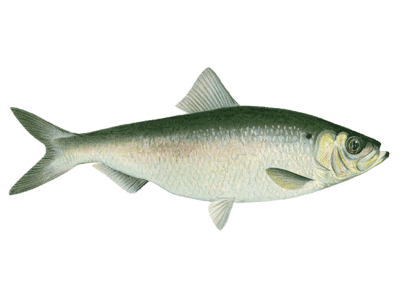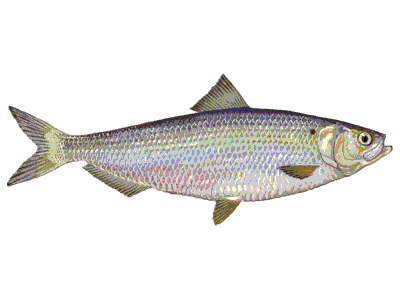The term river herring is collectively applied to two species of fish, the alewife (Alosa aestivalis), and blueback herring (Alosa psuedoharengus).

The alewife is bright silver in color, with a dark back, and black spot directly behind the gill opening. Some individuals exhibit up to 9 dark spots of varying intensity along the upper body. Their underside comes to a point with a single row of scales folded over the edge, resulting in a sharp saw like edge.

The blueback herring is similar in color to the alewife, except for the top of the back which is deep bluish green. Blueback herring are also more elongated and have smaller eyes than alewives.
The most distinguishing characteristic of these species is the color of their peritoneum (abdominal cavity lining). The alewife’s peritoneum is pale with dusky spots while the blueback herring’s peritoneum is dark gray to black in color. Both species reach lengths of approximately 15 inches.
Migratory populations of river herring reside in marine environments, migrating each spring into freshwater rivers, streams, and lakes to spawn. Studies indicate that river herring travel as much as 1200 miles or more during spawning migrations. Their life cycle is thought to be similar to those of American shad and hickory shad.
Landlocked populations do not migrate and complete their entire life cycle in freshwater lakes. Landlocked river herring are notably smaller in size than their migratory counterparts. Otherwise, there are no distinctive characteristics that distinguish landlocked populations from their anadromous counterparts.
River herring are caught by recreational anglers during their spring spawning runs. In most areas, anglers cast shad darts, small jigs, or spoons for river herring. They are also caught with fly rods and small, shiny fly patterns. Although river herring are rarely harvested for the table, they are highly valued as bait for striped bass and other species.
Anadromous river herring from Maine to Florida are managed cooperatively by the Atlantic States Marine Fisheries Commission (ASMFC) through the Fisheries Management Plan for Shad and River Herring (FMP).
The 2012 ASMFC Benchmark Stock Assessment for River Herring found that “the overall coastwide population of river herring (alewife and blueback herring) stocks on the US Atlantic coast is depleted to near historic lows”.
Similar Species